2018 PEUGEOT EXPERT fog light
[x] Cancel search: fog lightPage 10 of 416

8
As a passenger, if you avoid connecting your
multimedia devices (film, music, video game
etc.), you will contribute towards limiting the
consumption of electrical energy, and so of
fuel.
Disconnect your portable devices before
leaving the vehicle.
Eco- driving
Eco-driving is a range of everyday practices that allow the motorist to optimise their fuel consumption and CO2 emissions.
Optimise the use of your
gearbox
With a manual gearbox, move off gently
and change up without waiting. During
acceleration, change up early.
With an automatic gearbox, favour automatic
mode and avoid pressing the accelerator
pedal heavily or suddenly.
The gear shift indicator invites you to engage
the most suitable gear: as soon as the
indication is displayed in the instrument panel,
follow it straight away.
For vehicles fitted with an automatic gearbox,
this indicator appears only in manual mode.
Drive smoothly
Maintain a safe distance between vehicles,
use engine braking rather than the
brake pedal, and press the accelerator
progressively. These practices contribute
towards a reduction in fuel consumption and
CO
2 emissions and also help reduce the
background traffic noise.
If your vehicle has cruise control, make use of
the system at speeds above 25
mph (40 km/h)
when the traffic is flowing well.
Control the use of your electrical
equipment
Before moving off, if the passenger
compartment is too warm, ventilate it by
opening the windows and air vents before
using the air conditioning.
Above 30
mph (50 km/h), close the windows
and leave the air vents open.
Consider using equipment that can help
keep the temperature in the passenger
compartment down (sunroof blind and window
blinds, etc.). Switch off the headlamps and front foglamps
when the ambient light level does not require
their use.
Avoid running the engine before moving off,
particularly in winter; your vehicle will warm up
much faster while driving. Unless it has automatic regulation, switch off
the air conditioning as soon as the desired
temperature has been reached.
Switch off the demisting and defrosting
controls, if these are not automatically
managed.
Switch off the heated seat as soon as
possible.
Eco-driving
Page 26 of 416

24
Warning/indicator lampStateCause Action/Observations
Service Temporarily on,
accompanied by the
display of a message. One or more minor faults for
which there is no specific
warning lamp have been
detected. Identify the cause of the fault using the message
displayed in the instrument panel.
You can deal with some problems yourself, such
as a door open or the start of saturation of the
particle filter (as soon as the traffic conditions allow,
regenerate the filter by driving at a speed of at least
37
mph (60 km/h), until the warning lamp goes off).
For any other problems, such as a fault with the tyre
under-inflation detection system, contact a PEUGEOT
dealer or a qualified workshop.
Fixed, accompanied
by the display of a
message. One or more major faults for
which there is no specific
warning lamp have been
detected Identify the cause of the fault using the message
displayed in the instrument panel; you must then
contact a PEUGEOT dealer or a qualified workshop.
Fixed, associated
with the flashing and
then fixed display of
the service spanner. The servicing interval has been
exceeded.
Only on BlueHDi Diesel versions.
Your vehicle must be ser viced as soon as possible.
Rear foglamps Fixed. The rear foglamps have been
switched on using the ring on the
lighting control stalk. Turn the ring on the lighting control stalk rear wards to
switch off the rear foglamps.
Instruments
Page 28 of 416

26
Warning/indicator lampStateCause Action/Observations
Lane depar ture
warning system Fixed.
The lane departure warning
system has been activated. The lane departure warning system is activated.
For more information on the Lane depar ture
warning system
, refer to the corresponding section.
Front foglamps Fixed. The front foglamps are switched
on using the ring on the lighting
control stalk. Turn the ring on the lighting control stalk rear ward
once to switch off the front foglamps.
Sidelamps Fixed. The lighting control stalk is in the
"Sidelamps" position.
Left-hand
direction
indicator Flashing with audible
signal.
The lighting control stalk has
been moved down.
Dipped beam
headlamps Fixed.
The lighting control stalk is in
the "Dipped beam headlamps"
position.
Main beam
headlamps Fixed.
The lighting control stalk has
been pulled towards you. Pull the lighting control stalk to return to dipped beam
headlamps.
Right-hand
direction
indicator
Flashing with audible
signal.
The lighting control stalk has
been moved up.
For more information on the Lighting control stalk , refer to the " Visibility" section.
Instruments
Page 133 of 416
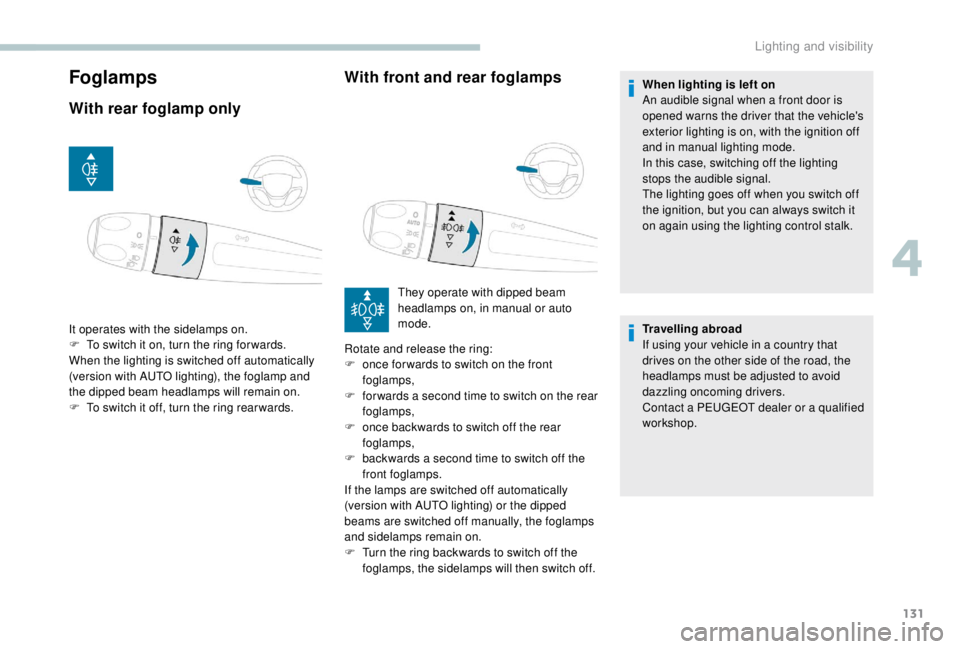
131
Foglamps
With rear foglamp onlyWith front and rear foglamps
It operates with the sidelamps on.
F
T o switch it on, turn the ring for wards.
When the lighting is switched off automatically
(version with AUTO lighting), the foglamp and
the dipped beam headlamps will remain on.
F
T
o switch it off, turn the ring rear wards. They operate with dipped beam
headlamps on, in manual or auto
mode.
Rotate and release the ring:
F
o
nce for wards to switch on the front
foglamps,
F
f
or wards a second time to switch on the rear
foglamps,
F
o
nce backwards to switch off the rear
foglamps,
F
b
ackwards a second time to switch off the
front foglamps.
If the lamps are switched off automatically
(version with AUTO lighting) or the dipped
beams are switched off manually, the foglamps
and sidelamps remain on.
F
T
urn the ring backwards to switch off the
foglamps, the sidelamps will then switch off. When lighting is left on
An audible signal when a front door is
opened warns the driver that the vehicle's
exterior lighting is on, with the ignition off
and in manual lighting mode.
In this case, switching off the lighting
stops the audible signal.
The lighting goes off when you switch off
the ignition, but you can always switch it
on again using the lighting control stalk.
Travelling abroad
If using your vehicle in a country that
drives on the other side of the road, the
headlamps must be adjusted to avoid
dazzling oncoming drivers.
Contact a PEUGEOT dealer or a qualified
workshop.
4
Lighting and visibility
Page 134 of 416
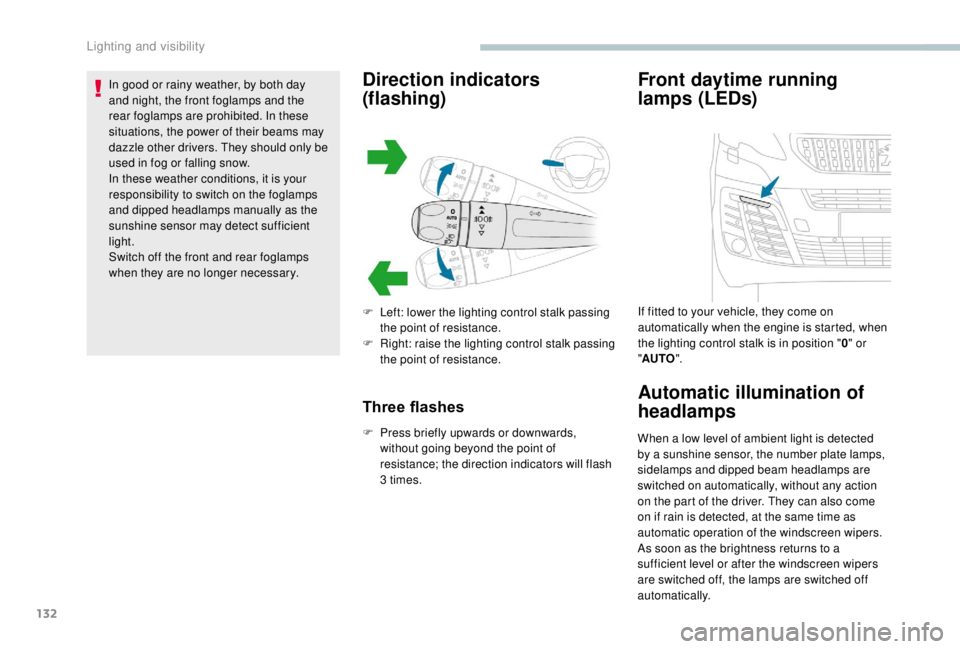
132
In good or rainy weather, by both day
and night, the front foglamps and the
rear foglamps are prohibited. In these
situations, the power of their beams may
dazzle other drivers. They should only be
used in fog or falling snow.
In these weather conditions, it is your
responsibility to switch on the foglamps
and dipped headlamps manually as the
sunshine sensor may detect sufficient
light.
Switch off the front and rear foglamps
when they are no longer necessary.Direction indicators
(flashing)
F Left: lower the lighting control stalk passing the point of resistance.
F
R
ight: raise the lighting control stalk passing
the point of resistance.
Three flashes
F Press briefly upwards or downwards, without going beyond the point of
resistance; the direction indicators will flash
3
times.
Front daytime running
lamps (LEDs)
If fitted to your vehicle, they come on
automatically when the engine is started, when
the lighting control stalk is in position " 0" or
" AUTO ".
Automatic illumination of
headlamps
When a low level of ambient light is detected
by a sunshine sensor, the number plate lamps,
sidelamps and dipped beam headlamps are
switched on automatically, without any action
on the part of the driver. They can also come
on if rain is detected, at the same time as
automatic operation of the windscreen wipers.
As soon as the brightness returns to a
sufficient level or after the windscreen wipers
are switched off, the lamps are switched off
automatically.
Lighting and visibility
Page 135 of 416
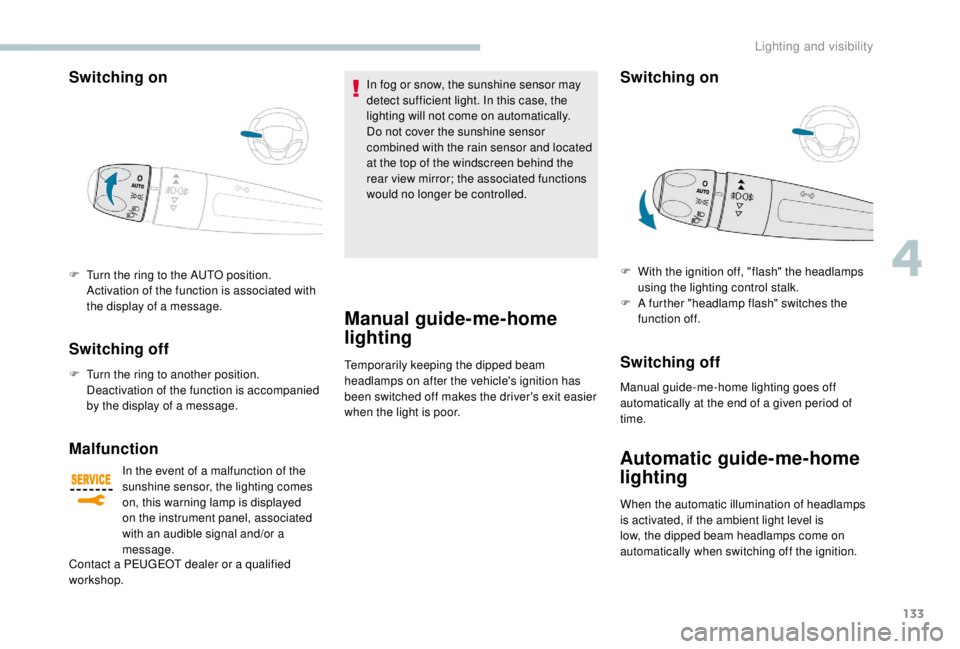
133
Switching on
F Turn the ring to the AUTO position. Activation of the function is associated with
the display of a message.
Switching off
F Turn the ring to another position. Deactivation of the function is accompanied
by the display of a message.
Malfunction
In the event of a malfunction of the
sunshine sensor, the lighting comes
on, this warning lamp is displayed
on the instrument panel, associated
with an audible signal and/or a
message.
Contact a PEUGEOT dealer or a qualified
workshop. In fog or snow, the sunshine sensor may
detect sufficient light. In this case, the
lighting will not come on automatically.
Do not cover the sunshine sensor
combined with the rain sensor and located
at the top of the windscreen behind the
rear view mirror; the associated functions
would no longer be controlled.
Manual guide-me-home
lighting
Temporarily keeping the dipped beam
headlamps on after the vehicle's ignition has
been switched off makes the driver's exit easier
when the light is poor.
Switching on
Switching off
Manual guide-me-home lighting goes off
automatically at the end of a given period of
time.
Automatic guide-me-home
lighting
F With the ignition off, "flash" the headlamps
using the lighting control stalk.
F
A f
urther "headlamp flash" switches the
function off.
When the automatic illumination of headlamps
is activated, if the ambient light level is
low, the dipped beam headlamps come on
automatically when switching off the ignition.
4
Lighting and visibility
Page 136 of 416
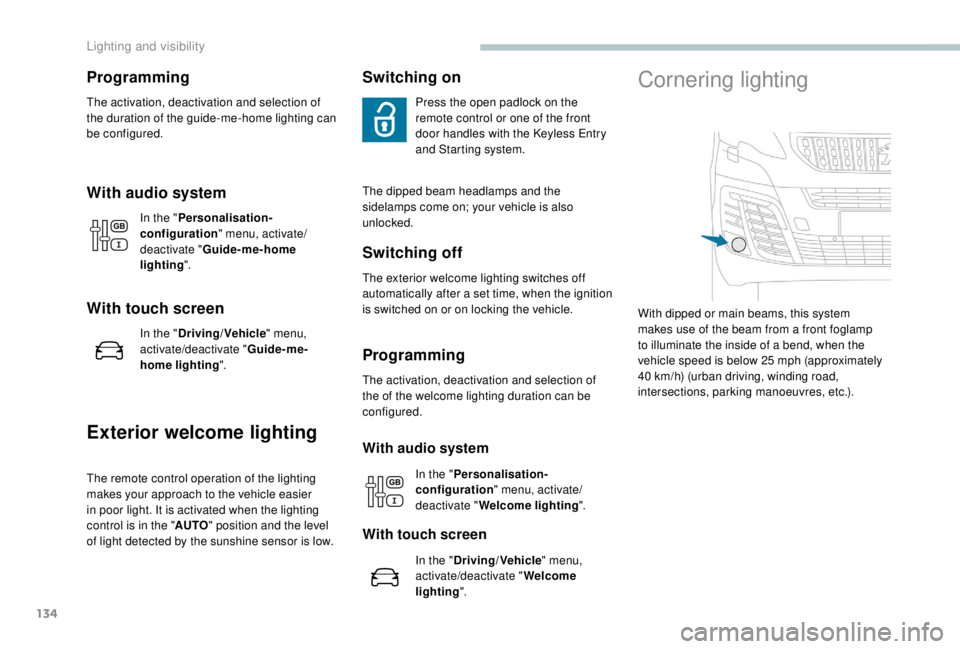
134
Programming
The activation, deactivation and selection of
the duration of the guide-me-home lighting can
be configured.
With audio system
In the "Personalisation-
configuration " menu, activate/
deactivate " Guide-me-home
lighting ".
With touch screen
In the "Driving/Vehicle " menu,
activate/deactivate " Guide-me-
home lighting ".
Exterior welcome lighting
The remote control operation of the lighting
makes your approach to the vehicle easier
in poor light. It is activated when the lighting
control is in the " AUTO" position and the level
of light detected by the sunshine sensor is low.
Switching on
Press the open padlock on the
remote control or one of the front
door handles with the Keyless Entry
and Starting system.
The dipped beam headlamps and the
sidelamps come on; your vehicle is also
unlocked.
Switching off
The exterior welcome lighting switches off
automatically after a set time, when the ignition
is switched on or on locking the vehicle.
Programming
The activation, deactivation and selection of
the of the welcome lighting duration can be
configured.
With audio system
In the " Personalisation-
configuration " menu, activate/
deactivate " Welcome lighting ".
With touch screen
In the "Driving/Vehicle " menu,
activate/deactivate " Welcome
lighting ".
Cornering lighting
With dipped or main beams, this system
makes use of the beam from a front foglamp
to illuminate the inside of a bend, when the
vehicle speed is below 25
mph (approximately
40
km/h) (urban driving, winding road,
intersections, parking manoeuvres, etc.).
Lighting and visibility
Page 138 of 416
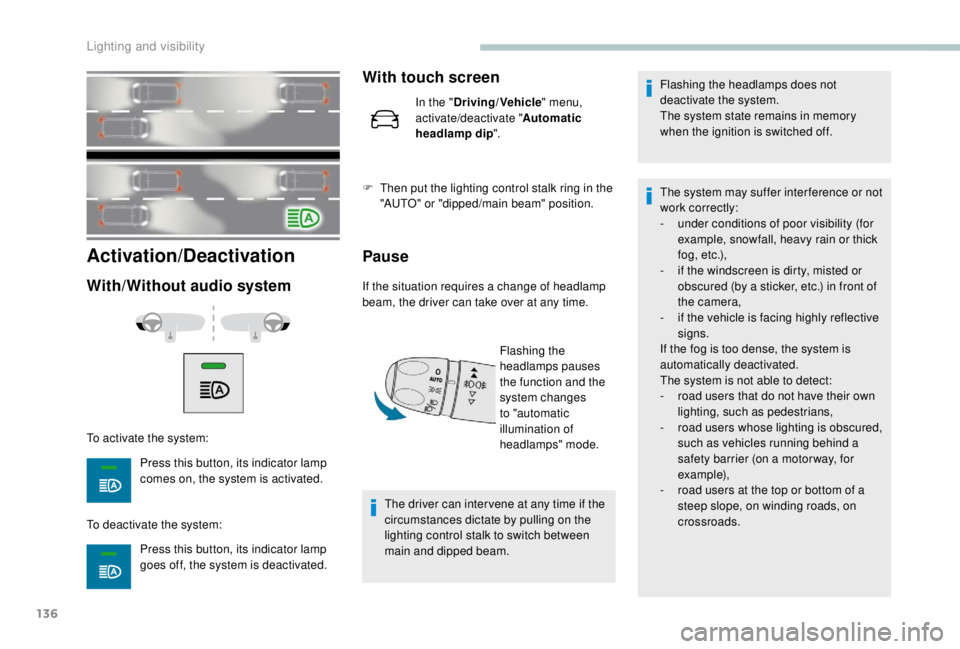
136
Activation/Deactivation
With/Without audio system
To activate the system:Press this button, its indicator lamp
comes on, the system is activated.
To deactivate the system: Press this button, its indicator lamp
goes off, the system is deactivated.
With touch screen
In the "Driving/Vehicle " menu,
activate/deactivate " Automatic
headlamp dip ".
F
T
hen put the lighting control stalk ring in the
"AUTO" or "dipped/main beam" position.
Pause
If the situation requires a change of headlamp
beam, the driver can take over at any time.
Flashing the
headlamps pauses
the function and the
system changes
to "automatic
illumination of
headlamps" mode.
The driver can inter vene at any time if the
circumstances dictate by pulling on the
lighting control stalk to switch between
main and dipped beam. Flashing the headlamps does not
deactivate the system.
The system state remains in memory
when the ignition is switched off.
The system may suffer inter ference or not
work correctly:
-
u
nder conditions of poor visibility (for
example, snowfall, heavy rain or thick
f o g , e t c .),
-
i
f the windscreen is dirty, misted or
obscured (by a sticker, etc.) in front of
the camera,
-
i
f the vehicle is facing highly reflective
signs.
If the fog is too dense, the system is
automatically deactivated.
The system is not able to detect:
-
r
oad users that do not have their own
lighting, such as pedestrians,
-
r
oad users whose lighting is obscured,
such as vehicles running behind a
safety barrier (on a motor way, for
example),
-
r
oad users at the top or bottom of a
steep slope, on winding roads, on
crossroads.
Lighting and visibility